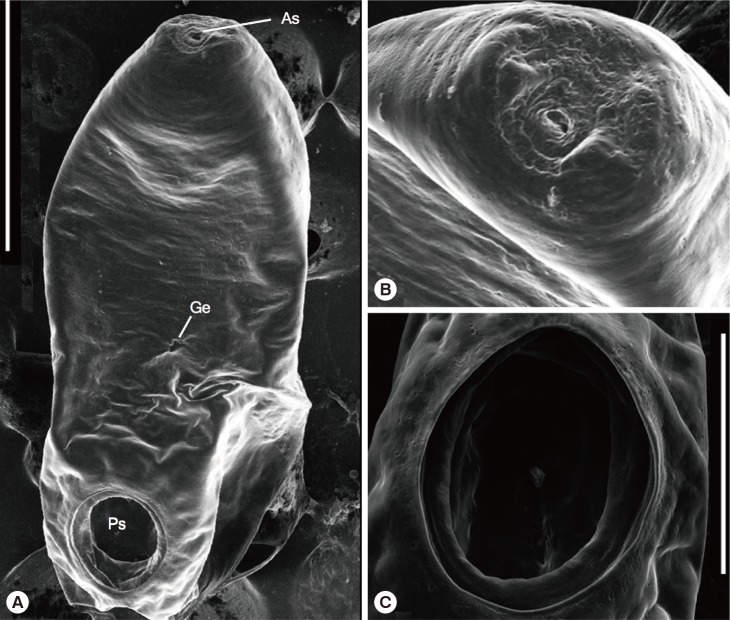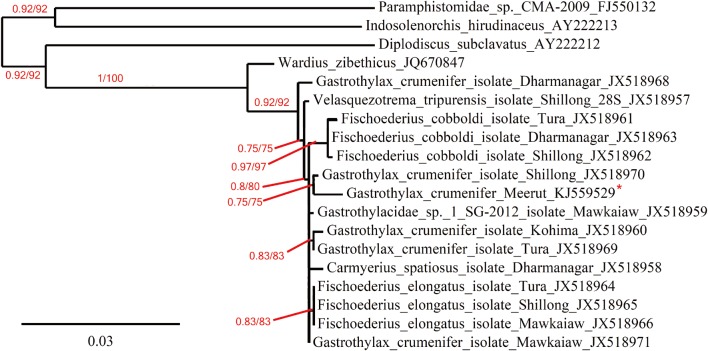The rumen worm, Gastrothylax crumenifer [1,2], is a blood-sucking trematode parasite found in the rumen of Capra hircus, Bos indicus, Bubalus bubalis, and Ovis aries. The infection causes anemia and accidental death of the animals which is serious and a major animal health problem [3]. The prevalence of this parasite is very high in tropical countries [4,5]. Some reports specified that, in tropical and subtropical areas, Paramphistomum cervi, P. Epiclitum, and G. crumenifer are the most prevalent parasites which cause the disease in ruminants [6,7,8].
Goats are a treasure home for different helminth parasites, thus, it is difficult to discriminate them because of their morphological similarity. Identification of parasites is usually done by microscopic observations of parasite's characters like the acetabulum, pharynx, and terminal genitalium. For any parasitic infection, accurate identification of the species involved is the first vital step for subsequent studies in the field of epidemiology, physiology, and immunology of the parasite. Therefore, it is important to identify the species found in goat on the basis of molecular characterization. Since G. crumenifer has been regarded as a valid species of the genus Gastrothylax on the basis of morphological characters [9]. It has been recorded from various localities in India, such as Uttar Pradesh, Jammu and Kashmir, Meghalaya, Himachal Pradesh, and Rajasthan [10,11,12,13,14], but no previous molecular studies have been done in Meerut region. Paramphistomiasis is important diseases of ruminants despite that little attention have received with respect to use of molecular tools for their validation, particularly in Indian region.
In the present work, we report molecular identification of G. crumenifer on the basis of sequences of the large subunit (LSU) ribosomal RNA (rRNA) 28S gene by using the PCR amplification and sequence analysis. The LSU or 28S rRNA is often regarded as a good phylogenetic marker, and its usage has provided a more fruitful resolution among the Metazoa [15]. It has been widely used to rectify species phylogenies of digenetic trematodes [16,17,18].
Flukes were collected from the rumens of freshly slaughtered goats at abattoirs located in the Sotiganj, Meerut (29°01' N, 77°45' E) of state U.P., western India. The flukes were washed extensively in saline solution, and some were stored at -20℃ until DNA extraction and molecular analysis were carried out. Others were used for morphological identification by optical and scanning electron microscopy (SEM). For morphological studies, the parasites were fixed in 70% ethanol for 24 hr and washed several times with water. They were then stained with Borax carmine, dehydrated through increasing grades of ethanol, and mounted in Canada balsam. The slides have been deposited in the Museum, Department of Zoology, Chaudhary Charan Singh University, U.P., India, under the voucher no. HS.TR/2013/01. For SEM, the specimens were fixed overnight with 3.5% glutaraldehyde. After then, the specimens were dehydrated through graded alcohol series and dried, mounted on aluminum stubs, and sputter coated with gold for 1 min. The observation and image acquisition was made in a JEOL-NeoScope JCM-5000 (NIKON-Type 108) SEM at 10 kV, according to the manufacturer's instructions.
Three flukes from each 2 ruminant in the study were used for extraction of genomic DNA. The genomic DNA extraction was performed on individual flukes using the Qiagen Tissue kit (QIAGEN, Hilden, Germany) according to the instructions specified by the manufacturer and stored at -20℃. The 28S sequences was amplified by PCR using the primers 28S F (5'-TAGGTCGACCCGCTGAAYTTAAGCA-3') as described by Littlewood et al. [19] and 28S R (5'-GCTATCCTGAGGGAAACTTCG-3') as described by Pawlowski et al. [20] with the annealing temperature 57℃. The PCR cycle, product purification, and sequencing reaction were performed as described by Chaudhary and Singh [21] with the same primers used in this work. Sequences of 28S were aligned using the programmes Clustal W and MUSCLE (3.7) for phylogenetic analysis. Pairwise distances were calculated using the Tamura-Nei substitution model using the software MEGA 6 [22]. Subsequent phylogenetic analysis of rDNA sequences was performed using the PhyML method with bootstrap values for n=100 replicates [23]. The obtained nucleotide sequence is available in GenBank, NCBI under accession no. KJ559529.
The stained slides of the parasite were examined using light microscopy. The SEM images show the full view of the worm (Fig. 1), with its oral and posterior suckers (acetabulum). The sequences from each DNA sample were identical without any ambiguities. The complete sequence of the 28S from G. crumenifer was 1,293 bp long. The nucleotide sequence similarity search for 28S rDNA from the parasites of Meerut region showed 98% identity with the same species (JX518970) in GenBank collected from the same host from northern part of India (Fig. 2). Beside the host C. hircus, from India, G. crumenifer was also reported from B. indicus, B. Frontalis, and B. bubalis. We also compared our sequences with the sequence data of G. crumenifer (JX518968, JX518960, JX518971, JX518969) obtained from these hosts to reveal the molecular characteristics (Fig. 2). Based on phylogenetic analyses, G. crumenifer was grouped with the same species isolated from C. hircus (JX 518970) (Fig. 2), both isolates were genetically close to each other. Maximum likelihood and Bayesian inference both placed G. crumenifer (KJ559529 and JX518970) in a same clade (Fig. 2) and gave highly similar tree topology for the position of G. crumenifer (Fig. 2). The Gastrothylacidae species forming a well-supported clade (100%) with 1 species of the Paramphistomatidae (JQ670847) (Fig. 2).
Among ruminants, of the different paramphistomoid families, various species of parasites mainly the members of Paramphistomidae and Gastrothylacidae, cause a disease collectively known as paramphistomiasis [24]. The family Gastrothylacidae is composed of 4 genera viz., Carmyerius Stiles and Goldberger, 1910 [25], Fischoederius Stiles and Goldberger, 1910 [25], Gastrothylax Poirier, 1883 [2], and Velasquezotrema Eduardo and Javellana, 1987 [26]. Due to thick bodies, it is hard to see the internal parts of these worms; that is why it is difficult to identify these worms. Morphological differences based on stained and mounted specimens have been widely used for discrimination of platyhelminthes species [27], but it is not possible to distinguish them on the basis of clinical, pathological, or immunological findings as they are morphologically very similar [28]. Therefore, in order to gain better understanding of the phylogeny of this group of parasites needs the use of molecular tools.
The results of the present study confirmed that 28S ribosomal DNA region is a useful molecular marker for species identification and platyhelminthes phylogeny [29,30,31,32]. Phylogenetic analyses results based on 28S sequences revealed that G. crumenifer from Meerut is closely related with the G. crumenifer obtained from Shillong, and G. crumenifer from infected goats at Meerut region showed to be identical to other G. crumenifer corresponding sequences in GenBank, in accordance with previous studies [32,33]. It is also confirmed that there is a highly conserved character of the 28S gene among G. crumenifer isolates from different regions of India [32,33]. The closeness of G. crumenifer from Meerut and Shillong regions is not surprising as they are the same species from 2 distantly apart locations in India (western India and northern India) and depicted within the same clade. The results also corroborate that the G. crumenifer species prevalent in India have not been identified properly due to the lack of genetic data. To determine the correct phylogeny and identification between the related species to this genus, further studies with additional molecular markers are needed.
This study reports the first molecular diagnosis and characterization of G. crumenifer from Meerut region, U.P., India. The current study is the first step toward expanding our knowledge of paramphistome fauna in this area. However, further studies are required to detect other paramphistome species, which may be concurrently infecting the same host or different hosts. Additional epidemiological and experimental studies must be undertaken to obtain specimens from other host samples from Meerut region, and further researches are required to determine the presence or absence of other species of paramphistomes in this region.








